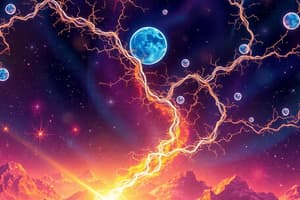Podcast
Questions and Answers
Which of the following is a primary action of Methylxanthines?
Which of the following is a primary action of Methylxanthines?
- Block phosphodiesterase (correct)
- Selective NE reuptake blockage
- Inhibit dopamine reuptake
- Stimulate presynaptic NE release
What is a common therapeutic use of Modafinil?
What is a common therapeutic use of Modafinil?
- Addressing narcolepsy (correct)
- Managing obesity
- Treating anxiety disorders
- Preventing hypertension
Atomoxetine works primarily as which type of medication?
Atomoxetine works primarily as which type of medication?
- Serotonin agonist
- CNS stimulant
- Dopamine reuptake inhibitor
- Selective NE reuptake blocker (correct)
What is a significant side effect associated with the use of CNS stimulants?
What is a significant side effect associated with the use of CNS stimulants?
Which drug is considered as the #1 treatment for children with ADHD?
Which drug is considered as the #1 treatment for children with ADHD?
What is one of the reasons CNS stimulants should be avoided in certain patients?
What is one of the reasons CNS stimulants should be avoided in certain patients?
Ephedrine functions through which mechanism of action?
Ephedrine functions through which mechanism of action?
What condition is not typically treated by Methamphetamine?
What condition is not typically treated by Methamphetamine?
What is the mechanism of action for Methylxanthines?
What is the mechanism of action for Methylxanthines?
Which of the following drugs is a prodrug of amphetamine?
Which of the following drugs is a prodrug of amphetamine?
Which CNS stimulant is primarily associated with dopamine reuptake inhibition?
Which CNS stimulant is primarily associated with dopamine reuptake inhibition?
What is a significant adverse effect associated with high doses of CNS stimulants?
What is a significant adverse effect associated with high doses of CNS stimulants?
Why should CNS stimulants be avoided in certain patient populations?
Why should CNS stimulants be avoided in certain patient populations?
Which of the following conditions is Modafinil primarily used to treat?
Which of the following conditions is Modafinil primarily used to treat?
What is the primary use of Ephedrine in a clinical setting?
What is the primary use of Ephedrine in a clinical setting?
Which drug is considered to have less addictive potential compared to traditional CNS stimulants?
Which drug is considered to have less addictive potential compared to traditional CNS stimulants?
Flashcards
Methylxanthines
Methylxanthines
CNS stimulants found in caffeine, chocolate, and tea. They work by blocking phosphodiesterase, increasing cAMP, and boosting alertness, while also blocking adenosine, increasing heart rate, and relaxing bronchial muscles.
Amphetamines
Amphetamines
CNS stimulants used to treat ADHD, narcolepsy, and obesity. They block the reuptake of norepinephrine and dopamine, increasing their levels at the synapse.
Lisdexamfetamine
Lisdexamfetamine
A prodrug of amphetamine, used to treat ADHD and obesity. It converts to amphetamine in the body, offering an alternative when tolerance to amphetamine develops.
Methylphenidate (Ritalin)
Methylphenidate (Ritalin)
Signup and view all the flashcards
Atomoxetine
Atomoxetine
Signup and view all the flashcards
CNS Stimulant Dependence
CNS Stimulant Dependence
Signup and view all the flashcards
CNS Stimulant Adverse Effects
CNS Stimulant Adverse Effects
Signup and view all the flashcards
Contraindications for CNS Stimulants
Contraindications for CNS Stimulants
Signup and view all the flashcards
Methylxanthines: What are they?
Methylxanthines: What are they?
Signup and view all the flashcards
Amphetamine: What does it do?
Amphetamine: What does it do?
Signup and view all the flashcards
Lisdexamfetamine: Why is it used?
Lisdexamfetamine: Why is it used?
Signup and view all the flashcards
Methylphenidate: What is its purpose?
Methylphenidate: What is its purpose?
Signup and view all the flashcards
Atomoxetine: How is it different?
Atomoxetine: How is it different?
Signup and view all the flashcards
Modafinil: What is its effect?
Modafinil: What is its effect?
Signup and view all the flashcards
Acute Psychosis from CNS Stimulants: What are the signs?
Acute Psychosis from CNS Stimulants: What are the signs?
Signup and view all the flashcards
Study Notes
Methylxanthines
- Found in caffeine, chocolate, and teas
- Mechanism of action: blocks phosphodiesterase (increasing cAMP and CNS alertness) and blocks adenosine (increasing heart rate and relaxing bronchial smooth muscle)
- Off-label uses: airflow obstruction (COPD/asthma), bradycardia after heart transplant, acute cardiac decompensation
Amphetamines
- Treat ADHD, ADD, narcolepsy, and obesity
- Mechanism of action: reuptake blocker, blocking the reuptake of norepinephrine (NE) and dopamine, increasing their levels at the synaptic terminal.
Lisdexamfetamine
- A prodrug of amphetamine
- Treats ADHD and obesity
- Can be used if tolerance develops to amphetamine or adderall
Methamphetamine
- Treats ADHD and obesity
- Lab-manufactured
- Highly abused drug
- Mechanism of action: reuptake blocker, blocking the reuptake of NE and dopamine increasing their levels at the synaptic terminal
Methylphenidate (Ritalin)
- Primarily affects dopamine
- First-line treatment for children with ADHD
- Treats ADD and ADHD
Atomoxetine
- Selective norepinephrine (NE) reuptake blocker
- First non-stimulant for ADHD
- Treats ADHD
- Fewer dopaminergic effects, more adrenergic effects
Ephedrine
- Mechanism of action: mixed-acting monoamine release, stimulating presynaptic NE release and acting as an α/β-adrenergic receptor agonist
- Therapeutic uses: anesthesia-induced hypertension, cardiogenic shock, nasal congestion
Modafinil
- Mechanism of action: atypical transporter, not fully understood
- Low euphoria, low adverse effects, low addiction
- Therapeutic uses: narcolepsy, obstructive sleep apnea, used by the military for wakefulness
CNS Stimulant Dependence
- High psychological dependence; highly addictive
- Schedule II drug
- Mild physical withdrawal; treatment usually not needed
- Focus on helping patients resist restarting compulsive use
CNS Adverse Effects
- Neurological: headache, dizziness, tremors, irritability, insomnia
- Appetite: appetite suppression, weight loss, growth suppression (children/adolescents) - consider "drug holidays"
- Mouth: xerostomia (dry mouth) due to vasoconstriction decreasing saliva, leading to tooth decay
- Cardiovascular: palpitations, chills, cardiac arrhythmias, chest pain; high doses lead to increased heart rate and blood pressure
Contraindications for CNS Stimulants
- History of drug abuse
- Hyperthyroidism
- Hypertension
- Psychosis
- Anxiety
- Depression
Acute Psychosis Associated with CNS Stimulants
- Panic states
- Anxiety
- Confusion
- Aggression
Studying That Suits You
Use AI to generate personalized quizzes and flashcards to suit your learning preferences.
Description
Explore the mechanisms and uses of methylxanthines and amphetamines in this pharmacology quiz. Learn about their effects on the central nervous system, treatment applications for ADHD, and the implications of drugs like methamphetamine. Test your knowledge on these important pharmacological agents.





